TheEnd
Member
After doing the rocker cover gaskets on my W211 E55, everything was fine for a week, but after a few days with longer driving, the car would start bucking on deceleration, rough downshifts, Check engine lights, and a rough idle.
Motorway driving was fine, but stop start traffic really showed up the problems.
This is very similar to a common 55 AMG "hiccup" that is often described after changing to a larger throttle body.
In this case, the symptoms are similar, but may come from different causes, with the link being errors with calculated and actual air intake charges.
It's a MAP based system on the 55's, so no airflow meter, only a Manifold pressure sensor which the ECU compares with the throttle position to see how much vacuum or boost is present to get an idea of engine load. (Engine "load" from an electronics point of view is essentially the amount of air it is consuming)
eg - with the throttle wide open, it could be pulling in maximum air and low vacuum or infact boost/ positive pressure, and with the throttle closed, it would have a high vacuum as the engine is sucking against the closed throttle and being "throttled"
You can have Wide open throttle just off idle, and at the redline, but with different amounts of air in the engine, and that is what the MAP sensor is checking.
So, back to the issues.
These are the types of codes present with an airleak or hiccup
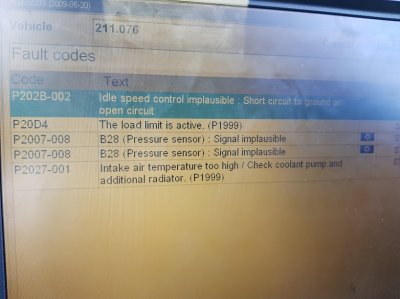
Ignore P2027, that's pretty self explanatory as being the IC aux pump and is something I'm going to keep an eye on and see if it returns, there's a Bosch 010 pump on the way to me now anyway.
The codes likely to be seen are
P2007 - 008 B28 Pressure sensor, signal implausible
P20D4 - Load Limit is active (P1999)
P202B - Idle speed control implausible - Short circuit
P20A2 - Idle speed control implausible - Check system for unmetered air
The B28 Pressure sensor is the MAP sensor, when standing at the front of the car looking at the engine, it should be on the left hand side of the rear of the supercharger. I couldn't get a glimpse of it even with an endoscope poking around. On the bright side, these rarely go wrong, so it isn't something you should be looking at changing.
P202B threw me for a while, short circuit is a poor or wrong description since there isn't an idle speed controller, the throttle does the idle. Ignore the short or open circuit bit on an M113K, just read it as poor idle control.
P20D4 has been debated before as to its meaning, and I'm fairly sure it can be taken at face value and it just means it is going to limit the power as a limp mode, usually by not activating the 'charger clutch.
Previously I did get a transmission code too for a harsh downshift when the idle was bucking and the car was bouncing down the road with the autobox trying to hold things together. If you get something like that, don't panic just yet.
Reading about the similar "hiccup" issue, it follows the same path, the characteristics are smooth driving from cold, everything OK on the motorways, but after half an hour or driving, coming off the throttle can lead to misfires and rough idles, and eventually the check engine light.
In my case, mine started 4-5 days after changing the breather and rocker covers, and that was far too much of a coincidence to be some of the other possible issues such as a bad MAP sensor or throttle. They have been reported as fixing the issues on other people's cars, but an airleak is heavily suspected.
The cause in my case was the evap/ purge valve pipe which is going to be very common as an issue after a rocker cover change.
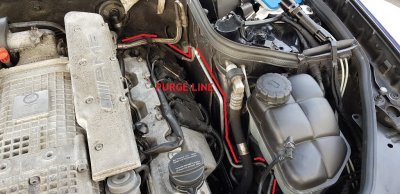
The purge line (for fuel tank vapour pressure bleed off) is held by a bracket on the rearmost rocker cover bolt. Removing this bolt and pushing the line out of the way frequently disconnects the pipe.
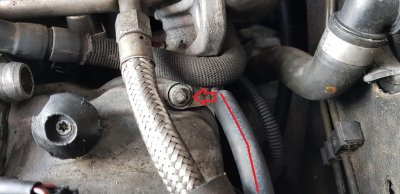

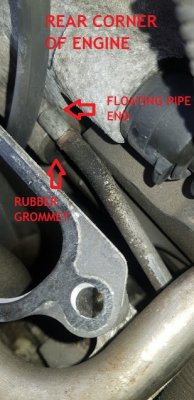
The fix is pretty easy, just needs to be pushed back home again. The "Surge tank" plenum needs to come off for access, these is just the 7 or so torx screws on the top (there's one in the rear section of "round" pipe too)
VITALLY IMPORTANT BIT!
Get an air duster in between the plenum and the charger and blow out as much as you can. I took mine off to find Southend Seafront hiding behind.
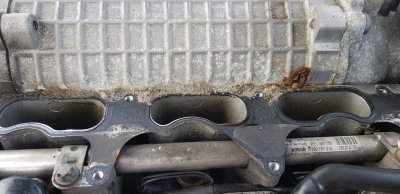
That needed a quick run to get Henry the vacuum cleaner on the job, a flat upholstery attachment down the intake ports, and a final clean by taping a clear silicone hose onto the end of the vacuum, dousing the ports in carb cleaner and sucking everything back out again. Grit will stick to oil traces, so vacuuming alone won't get everything out.
Ebay is full of endoscopes that will plug into your smartphone for checking out the condition.
In real life, it's going to be very hard to avoid some dirt getting down there, but blowing out as much as you can first, and having a vacuum cleaner ready will help clean things up.
I can't comment on how safe it is for a vac to suck up carb cleaner and fumes, so if you are doing this, make sure that your assistant holds the vacuum and stands well away from you, and maybe have ear protection. If it does explode, assistants usually have a safety feature where they will run off to douse themselves with water, and you can carry on with the engine work.
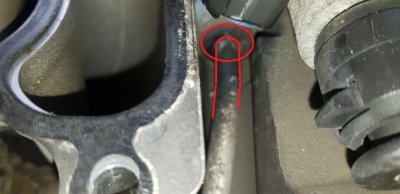
Pipe finally reseated.
TL; DR version-
If you've changed your rocker covers and the idle has gone terrible with deceleration misfires and check engine lights, check the purge valve pipe since it will usually get pulled out of the seat when moving the purge line bracket away from the rocker cover, and it's pretty much invisible without the plenum off, and you'll really struggle to get it back in with getting the plenum off to see what you are doing
Motorway driving was fine, but stop start traffic really showed up the problems.
This is very similar to a common 55 AMG "hiccup" that is often described after changing to a larger throttle body.
In this case, the symptoms are similar, but may come from different causes, with the link being errors with calculated and actual air intake charges.
It's a MAP based system on the 55's, so no airflow meter, only a Manifold pressure sensor which the ECU compares with the throttle position to see how much vacuum or boost is present to get an idea of engine load. (Engine "load" from an electronics point of view is essentially the amount of air it is consuming)
eg - with the throttle wide open, it could be pulling in maximum air and low vacuum or infact boost/ positive pressure, and with the throttle closed, it would have a high vacuum as the engine is sucking against the closed throttle and being "throttled"
You can have Wide open throttle just off idle, and at the redline, but with different amounts of air in the engine, and that is what the MAP sensor is checking.
So, back to the issues.
These are the types of codes present with an airleak or hiccup

Ignore P2027, that's pretty self explanatory as being the IC aux pump and is something I'm going to keep an eye on and see if it returns, there's a Bosch 010 pump on the way to me now anyway.
The codes likely to be seen are
P2007 - 008 B28 Pressure sensor, signal implausible
P20D4 - Load Limit is active (P1999)
P202B - Idle speed control implausible - Short circuit
P20A2 - Idle speed control implausible - Check system for unmetered air
The B28 Pressure sensor is the MAP sensor, when standing at the front of the car looking at the engine, it should be on the left hand side of the rear of the supercharger. I couldn't get a glimpse of it even with an endoscope poking around. On the bright side, these rarely go wrong, so it isn't something you should be looking at changing.
P202B threw me for a while, short circuit is a poor or wrong description since there isn't an idle speed controller, the throttle does the idle. Ignore the short or open circuit bit on an M113K, just read it as poor idle control.
P20D4 has been debated before as to its meaning, and I'm fairly sure it can be taken at face value and it just means it is going to limit the power as a limp mode, usually by not activating the 'charger clutch.
Previously I did get a transmission code too for a harsh downshift when the idle was bucking and the car was bouncing down the road with the autobox trying to hold things together. If you get something like that, don't panic just yet.
Reading about the similar "hiccup" issue, it follows the same path, the characteristics are smooth driving from cold, everything OK on the motorways, but after half an hour or driving, coming off the throttle can lead to misfires and rough idles, and eventually the check engine light.
In my case, mine started 4-5 days after changing the breather and rocker covers, and that was far too much of a coincidence to be some of the other possible issues such as a bad MAP sensor or throttle. They have been reported as fixing the issues on other people's cars, but an airleak is heavily suspected.
The cause in my case was the evap/ purge valve pipe which is going to be very common as an issue after a rocker cover change.

The purge line (for fuel tank vapour pressure bleed off) is held by a bracket on the rearmost rocker cover bolt. Removing this bolt and pushing the line out of the way frequently disconnects the pipe.



The fix is pretty easy, just needs to be pushed back home again. The "Surge tank" plenum needs to come off for access, these is just the 7 or so torx screws on the top (there's one in the rear section of "round" pipe too)
VITALLY IMPORTANT BIT!
Get an air duster in between the plenum and the charger and blow out as much as you can. I took mine off to find Southend Seafront hiding behind.

That needed a quick run to get Henry the vacuum cleaner on the job, a flat upholstery attachment down the intake ports, and a final clean by taping a clear silicone hose onto the end of the vacuum, dousing the ports in carb cleaner and sucking everything back out again. Grit will stick to oil traces, so vacuuming alone won't get everything out.
Ebay is full of endoscopes that will plug into your smartphone for checking out the condition.
In real life, it's going to be very hard to avoid some dirt getting down there, but blowing out as much as you can first, and having a vacuum cleaner ready will help clean things up.
I can't comment on how safe it is for a vac to suck up carb cleaner and fumes, so if you are doing this, make sure that your assistant holds the vacuum and stands well away from you, and maybe have ear protection. If it does explode, assistants usually have a safety feature where they will run off to douse themselves with water, and you can carry on with the engine work.

Pipe finally reseated.
TL; DR version-
If you've changed your rocker covers and the idle has gone terrible with deceleration misfires and check engine lights, check the purge valve pipe since it will usually get pulled out of the seat when moving the purge line bracket away from the rocker cover, and it's pretty much invisible without the plenum off, and you'll really struggle to get it back in with getting the plenum off to see what you are doing




